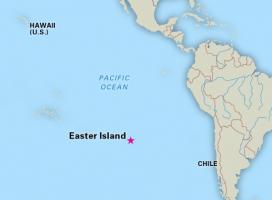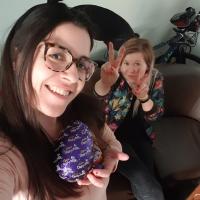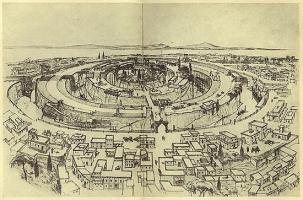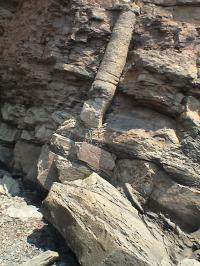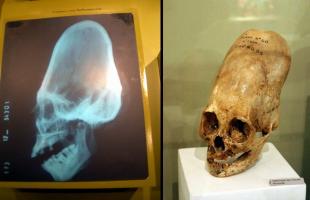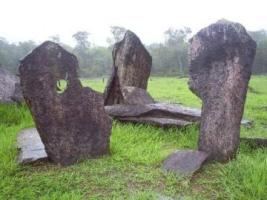Evidence: manioc on Easter Island

Greetings,
Abundant evidence exists for the hypothesis that there were contacts between the Easter Island and the South American mainland in earliest times. This evidence is so plentiful that it is hard to believe that this hypothesis will not be accepted by now by our academic mainstream. And yet it is not. We can only speculate why this may be so.
Not only this, but there's also very good evidence that the earliest settlers on Easter Island came from S. America. As archaeological evidence demonstrates, the culture of the earliest Easter Island peoples shows so much affinity with the pre-Inca Tiahuanaco civilization that this matter should have been settled by now. Also, the oral narratives of the native Easter Islanders just happen to be saying the very same thing. Detailed traditional narratives exist telling us that the first Easter Islanders came from the East, i.e. from S. America.
So what is the problem? Why are our scholars so reluctant to accept all this? Who can tell...
In any case, let's look at the case of the manioc (Manihot), also known as cassava, a very useful crop plant native to S. America. It is a tropical tuber propagated by stem cuttings, and it was domesticated by Amerindians in ancient times.
First, a little about history. As far as we know, Easter Island was first visited by the Europeans on Easter Day 1722, by the Dutch. It seems that the native society was flourishing at that time. The population was large, seemingly multiracial, and peaceful. Although the Dutch only spent one day on the island, they managed to get into some sort of trouble and shoot a few natives before they left.
The next visit came by the Spanish nearly 50 years later, in 1770. The viceroy of Peru, Don Manuel de Amat, sent out an expedition of two ships under the command of Felipe Gonzalez y Haedo to look for the mysterious island reported by the Dutch. Gonzalez claimed the island for Spain. His expedition spent 6 days on the island, and they left detailed records of what they found there.
Earliest European visitors noticed that the fishing in the area was very poor. The islanders were not fishermen, and their sustenance came for the most part from agriculture, in which they were very skillful. Among a number of other food crops, Gonzalez told us, the islanders cultivated yuka. The word yuka is the term for manioc in various indigenous languages of Peru and other Central and South American countries, and this plant was surely known to Gonzalez very well.
This is what Thor Heyerdahl writes in his EASTER ISLAND: THE MYSTERY SOLVED, 1989:
"When the documents of the Gonzalez expedition were translated into English and published by the prominent British scholar Bolton G. Corney in 1908, he was so dumbfounded at finding a reference to S. American yuca on Easter Island prior to European influence, that he concealed or obfuscated the evidence of manioc. In one instance he rendered the word yuca erroneously as "taro"; in three others he left it untranslated, adding erroneous footnotes confusing the readers. Not until 1986 did a Spanish scholar Francisco Mellen Blanco revise and bring together all the documents from the Gonzalez expedition, and in 1988 Robert Langdon of the Australian National University caused a sensation in the scientific world by publishing in THE GEOGRAPHIC JOURNAL a paper entitled MANIOC: A LONG-CONCEALED KEY TO THE ENIGMA OF EASTER ISLAND [Geogr. Journ. 154, # 3(Nov. 1988), pp. 324-336, London]. According to Langdon, Corney in his translation acted as he did because, in the climate of his times, he simply could not believe that manioc could have reached Easter Island prior to European influence. Langdon's conclusion was that the fact that manioc was clearly reported as cultivated on that Polynesian island in 1770 'greatly strengthens the case for prehistoric American Indian influence on Easter Island and other islands of eastern Polynesia'". (p. 31)
To me, this seems like undeniable historical evidence. Who would like to deny it, and why?
And furthermore, manioc certainly doesn't stand alone in this case. Other cultivated plants described by first European visitors, such as the sweet potato, the main crop on Easter Island from ancient times, add to the near certainty that Easter island was visited, and probably first settled, by ancient South Americans.
Best regards,
Yuri.
Yuri Kuchinsky in Toronto -=O=- [23]http://www.io.org/~yuku
Comparative studies of primitive art have probably been jeopardized by the zeal of investigators of cultural contacts and borrowings. But let us state in no uncertain terms that these studies have been jeopardized even more by intellectual pharisees who prefer to deny obvious relationships because science does not yet provide an adequate method for their interpretation
-=- Claude Levi-Strauss, ANTHROPOLOGIE STRUCTURALE, 1958








